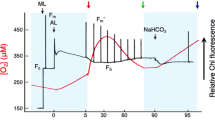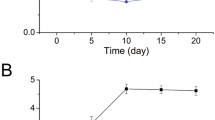Abstract
Incubation of Chlamydomonas reinhardtii cells under nutrient deficiency results in the faster initial rise in the light-induced chlorophyll fluorescence kinetic curve. We showed that short-term anaerobic incubation of algal cells altered initial fluorescence in a way similar to nutrient starvation, suggesting an important role of the plastoquinones redox state in the observed effect. Bi-component analysis of highly resolved initial fluorescence rise kinetics in sulfur- or oxygen-depleted C. reinhardtii cells suggested that one of the mechanisms underlying the observed phenomenon involves primary closure (photochemical inactivation via Qa reduction) of β-type PSII as compared to α-PSII. Moreover, results of modeling of the fluorescence curve brought us to the conclusion that accumulation of closed centers in α-PSII supercomplexes may also cause a faster initial fluorescence rise. The observed correlations between nutrient supply rate and initial fluorescence rise pattern in green algae can serve to characterize culture nutritional status in vivo.








Similar content being viewed by others
Abbreviations
- Chl:
-
Chlorophyll
- PSII:
-
Photosystem II
- PSU:
-
Photosynthetic unit
- LHCII:
-
Light-harvesting complex II
- PQ:
-
Plastoquinon
- Pheo:
-
Pheophytin
- OEC:
-
Oxygen-evolving complex
- PEE :
-
Energy exchange probability
- PPFD:
-
Photosynthetic photon flux density
References
Antal TK, Rubin AB (2008) In vivo analysis of chlorophyll a fluorescence induction. Photosynth Res 96:217–226
Antal TK, Volgusheva AA, Kukarskih GP, Bulychev AA, Krendeleva TE, Rubin AB (2006) Effects of sulfur limitation on photosystem II functioning in Chlamydomonas reinhardtii as probed by chlorophyll a fluorescence. Physiol Plant 128:360–367
Antal TK, Krendeleva TE, Rubin AB (2007) Study of photosystem 2 heterogeneity in the sulfur-deficient green alga Chlamydomonas reinhardtii. Photosynth Res 94:13–22
Antal TK, Mattila H, Hakala-Yatkin M, Tyystjärvi T, Tyystjärvi E (2010) Acclimation of photosynthesis to nitrogen deficiency in Phaseolus vulgaris. Planta 232:887–898
Antal TK, Krendeleva TE, Pashchenko VZ, Rubin AB, Stensjo K, Tyystjärvi E, Los DA, Carpentier R, Nishihara H, Allakhverdiev S (2012) Photosynthetic hydrogen production: mechanisms and approaches. In: Azbarm N, Levin D (eds) State of the art and progress in production of biohydrogen. Bentham Science Publishers, Bussum, pp 25–54
Aro E-M, Suorsa M, Rokka A, Allahverdiyeva Y, Paakkarinen V, Saleem A, Battchikova N, Rintamäki E (2005) Dynamics of photosystem II: a proteomic approach to thylakoid protein complexes. J Exp Bot 56:347–356
Belyaeva NE, Schmitt F-J, Stefen R, Paschenko VZ, Riznichenko GY, Chemeris YK, Renger G, Rubin AB (2008) PSII model-based simulations of single turnover flash-induced transients of fluorescence yield monitored within the time domain of 100 ns–10 s on dark-adapted Chlorella pyrenoidosa cells. Photosynth Res 98:105–119
Corneille S, Cournac L, Guedeney G, Havaux M, Peltier G (1998) Reduction of the plastoquinone pool by exogenous NADH and NADPH in higher plant chloroplasts-characterization of a NAD(P)H-plastoquinone oxidoreductase activity. Biochim Biophys Acta 1363:59–69
Danielsson R, Suorsa M, Paakkarinen V, Albertsson PA, Styring S, Aro E-M, Mamedov F (2006) Dimeric and monomeric organization of photosystem II. Distribution of five distinct complexes in the different domains of the thylakoid membrane. J Biol Chem 281:14241–14249
Dekker JP, Boekema EJ (2005) Supramolecular organization of thylakoid membrane proteins in green plants. Biochim Biophys Acta 1706:12–39
Demmig-Adams B, Cohu CM, Muller O, Adams WW (2012) Modulation of photosynthetic energy conversion efficiency in nature: from seconds to seasons. Photosynth Res 113:75–88
Devault D, Govindjee (1990) Photosynthetic glow peaks and their relationship with the free-energy changes. Photosynth Res 24:175–181
Finazzi G, Furia A, Barbagallo RP, Forti G (1999) State transitions, cyclic and linear electron transport and photophosphorylation in Chlamydomonas reinhardtii. Biochim Biophys Acta 1413:117–129
Guissé B, Srivastava A, Strasser RJ (1995) The polyphasic rise of the chlorophyll a fluorescence (O–K–J–I–P) in heat-stressed leaves. Archs Sci Genève 48:147–160
Hohmann-Marriott HM, Takizawa K, Eaton-Rye JJ, Mets L, Minagawa J (2010) The redox state of the plastoquinone pool directly modulates minimum chlorophyll fluorescence yield in Chlamydomonas reinhardtii. FEBS Lett 584:1021–1026
Inoue Y, Yamashita T, Kobayashi Y, Shibata K (1977) Thermoluminescence changes during inactivation and reactivation of the oxygen-evolving system in isolated chloroplasts. FEBS Lett 82:303–306
Johnson GN, Boussac A, Rutherford AW (1994) The origin of the 40–50 °C thermoluminescence band in photosystem II. Biochim Biophys Acta 1184:85–92
Johnson GN, Rutherford AW, Krieger A (1995) A change in the midpoint potential of the quinone QA in photosystem II is associated with photoactivation of the primary quinone acceptor QA. Biochim Biophys Acta 1229:201–207
Joliot A, Joliot P (1964) Etude cinétique de la réaction photochimique libérant l’oxygène au cours de la photosynthèse. CR Acad Sci Paris 258:4622–4625
Joly D, Carpentier R (2009) Sigmoidal reduction kinetics of the photosystem II acceptor side in intact photosynthetic materials during fluorescence induction. Photochem Photobiol Sci 8:167–173
Krieger A, Weis E, Demeter S (1993) Low pH induced Ca2+ ion release in the water-splitting system is accompanied by a shift in the mid-point redox potential of the primary quinone acceptor QA. Biochim Biophys Acta 1144:411–418
Krieger A, Rutherford AW, Johnson GN (1995) On the determination of the redox midpoint potential of the primary quinone acceptor, QA, in photosystem II. Biochim Biophys Acta 1229:193–201
Krieger-Liszkay A, Rutherford AW (1998) Influence of herbicide binding on the redox potential of the quinone acceptor in photosystem II: relevance to photodamage and phytotoxicity. Biochemistry 37:17339–17344
Larsson UK, Anderson JM, Andersson B (1987) Variations in the relative content of the peripheral and inner light-harvesting chlorophyll a/b-protein complex (LHC II) subpopulations during thylakoid light adaptation and development. Biochim Biophys Acta 894:69–75
Lavergne J, Briantais JM (1996) Photosystem II heterogeneity. In: Ort DR, Yocum CF (eds) Oxygenic photosynthesis: the light reactions. Kluwer Academic Publishers, Dordrecht, pp 265–287
Lazár D (2006) The polyphasic chlorophyll a fluorescence rise measured under high intensity of exciting light. Funct Plant Biol 33:9–30
Lazár D (2009) Modelling of light-induced chlorophyll a fluorescence rise (O–J–I–P transient) and changes in 820 nm-transmittance signal of photosynthesis. Photosynthetica 47:483–498
Laźar D (2003) Chlorophyll a fluorescence rise induced by high light illumination of dark-adapted plant tissue studied by means of a model of photosystem II and considering photosystem II heterogeneity. J Theor Biol 220:469–503
Lorenz T, Cysewski GR (2000) Commercial potential for Haematococcus microalgae as a natural source of astaxanthin. Trends Biotechnol 18:160–167
Makarov SS, Grachev EA, Antal TK (2012) Mathematical modeling of photosynthetic electron transport chain considering spatial heterogeneity of the thylakoid membrane. Math Biol Bioinform 7:508–528
Mamedov F, Danielsson R, Gadjieva R, Albertsson PA, Styring S (2008) EPR characterization of photosystem II from different domains of the thylakoid membrane. Biochemistry 47:3883–3891
Melis A, Homann P (1975) Kinetic analysis of the fluorescence induction in 3-(3,4-dichlorophenyl)-1,1-dimethylurea poisoned chloroplasts. Photochem Photobiol 21:431–437
Melis A, Homann P (1976) A selective effect of Mg2+ on the photochemistry at one type of reaction center in photosystem II of chloroplasts. Arch Biochem Biophys 190:523–530
Nagy V, Tengölics R, Schansker G, Rákhely G, Kovács KL, Garab G, Tóth SZ (2012) Stimulatory effect of ascorbate, the alternative electron donor of photosystem II, on the hydrogen production of sulfur-deprived Chlamydomonas reinhardtii. Int J Hydrogen Energy 37:8864–8871
Nield J, Kruse O, Ruprecht J, da Fonseca P, Büchel C, Barber J (2000) Three dimensional structure of Chlamydomonas reinhardtii and Synechococcus elongatus photosystem II complexes allows for comparison of their oxygen-evolving complex organization. J Biol Chem 275:27940–27946
Pogosyan SI, Kazamirko YV, Galchuk SV, Konyukhov IV, Rubin AB (2009) Application of fluorimeter «MEGA-25» to estimate the quantity of phytoplankton and assess its photosynthetic status. Water Chem Ecol 6:34–40
Schansker G, Tóth SZ, Kovács L, Holzwarth AR, Garab G (2011) Evidence for a fluorescence yield change driven by a light-induced conformational change within photosystem II during the fast chlorophyll a fluorescence rise. Biochim Biophys Acta 1807:1032–1043
Schmitz P, Maldonado-Rodriguez R, Strasser RJ (2001) Evaluation of the nodulated status of Vigna unguiculata probed by the JIP-test based on the chlorophyll a fluorescence rise. In: Proceedings of the 12th international congress on photosynthesis, S36-012. CSIRO Publishing, Melbourne (CD-ROM)
Schreiber U, Neubauer C (1990) O2-dependent electron flow, membrane energization and the mechanism of non-photochemical quenching of chlorophyll fluorescence. Photosynth Res 25:279–293
Srivastava A, Guissé B, Greppin H, Strasser RJ (1997) Regulation of antenna structure and electron transport in photosystem II of Pisum sativum under elevated temperature probed by the fast polyphasic chlorophyll a fluorescence transient: OKJIP. Biochim Biophys Acta 1320:95–106
Stirbet A, Govindjee (2011) On the relation between the Kautsky effect (chlorophyll a fluorescence induction) and photosystem II: Basics and applications of the OJIP fluorescence transient. Photochem Photobiol B 104:236–257
Stirbet A, Govindjee (2012) Chlorophyll a fluorescence induction: a personal perspective of the thermal phase, the J–I–P rise. Photosynth Res 113:15–61
Stirbet A, Govindjee, Strasser BJ, Strasser RJ (1998) Chlorophyll a fluorescence induction in higher plants: modelling and numerical simulation. J Theor Biol 193:131–151
Strasser RJ (1978) The grouping model of plant photosynthesis. In: Akoyunoglou G (ed) Chloroplast development. Elsevier, Amsterdam, pp 513–524
Strasser BJ (1997) Donor side capacity of photosystem II probed by chlorophyll a fluorescence transients. Photosynth Res 52:147–155
Strasser RJ, Govindjee (1992) The F O and the O–J–I–P fluorescence rise in higher plants and algae. In: Argyroudi-Akoyunoglou JH (ed) Regulation of chloroplast biogenesis. Plenum Press, New York, pp 423–426
Strasser RJ, Tsimilli-Michael M, Srivastava A (2005) Analysis of chlorophyll a fluorescence transient. In: Papageorgiou GC, Govindjee (eds) Chlorophyll fluorescence: a signature of photosynthesis. Kluwer Academic Publishers, Dordrecht, pp 321–362
Tóth SZ, Schansker G, Garab G, Strasser RJ (2007a) Photosynthetic electron transport activity in heat-treated barley leaves: the role of internal alternative electron donors to photosystem II. Biochim Biophys Acta 1767:295–305
Tóth SZ, Schansker G, Strasser RJ (2007b) A non-invasive assay of the plastoquinone pool redox state based on the OJIP-transient. Photosynth Res 93:193–203
Tyystjärvi E, Rantamäki S, Tyystjärvi J (2009) Connectivity of photosystem II is the physical basis of retrapping in photosynthetic thermoluminescence. Biophys J 96:3735–3743
Vass I, Kirilovsky D, Etienne AL (1999) UV-B radiation-induced donor- and acceptor-side modifications of Photosystem II in the cyanobacterium Synechocystis sp. PCC 6803. Biochemistry 38:12786–12794
Volgusheva AA, Zagidullin VE, Antal TK, Korvatovsky BN, Krendeleva TE, Paschenko VZ, Rubin AB (2007) Examination of chlorophyll fluorescence decay kinetics in sulfur deprived algae Chlamydomonas reinhardtii. Biochim Biophys Acta 1767:559–564
Wykoff DD, Davies JP, Melis A, Grossman A (1998) The effects of phosphorus and sulfur deprivation on photosynthetic electron transport in Chlamydomonas reinhardtii. Plant Physiol 117:129–139
Zhu XG, Govindjee, Baker NR, de Sturler E, Ort DR, Long SP (2005) Chlorophyll a fluorescence induction kinetics in leaves predicted from a model describing each discrete step of excitation energy and electron transfer associated with photosystem II. Planta 223:114–133
Acknowledgments
This study was supported by the Russian Foundation for Basic Research (10-04-00864-a) and Russian Federal Target Programme (8077).
Author information
Authors and Affiliations
Corresponding author
Rights and permissions
About this article
Cite this article
Antal, T.K., Kolacheva, A., Maslakov, A. et al. Study of the effect of reducing conditions on the initial chlorophyll fluorescence rise in the green microalgae Chlamydomonas reinhardtii . Photosynth Res 114, 143–154 (2013). https://doi.org/10.1007/s11120-012-9789-7
Received:
Accepted:
Published:
Issue Date:
DOI: https://doi.org/10.1007/s11120-012-9789-7




